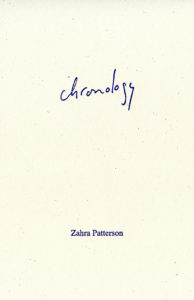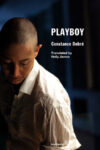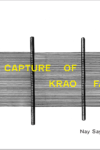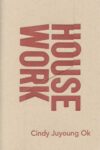
[Ugly Duckling Presse; 2018]
Chronology, Zahra Patterson’s debut book of literary non-fiction, was released through Ugly Duckling Presse in 2018. My best friend Neelufar mailed a copy to my address in Cape Town when she began an apprenticeship at Ugly Duckling last year, and I promised to write a review once I received it. But, as fate would have it, the post office in my neighborhood was at that time closed for several months — rumor is that in a rapidly-gentrifying Woodstock, they couldn’t afford to pay rent. Combine this with recent grief over loved ones lost, it is only now I am able to make sense of this text. And because a promise to a friend is a promise I wouldn’t dare break, this review comes later than I had first intended .
Although, I think the timing is appropriate — Chronology begins with a delay. The first page is a screenshot of an email dated 7 January 2011 from Liepollo Rantekoa — who was, in her own words, the “founder, conceptualizer, and curator” of the Ba re e ne re Literary Festival in Lesotho and an editor for Chimurenga, — telling Patterson, among other things, to get a Sesotho/English dictionary. On 3 December 2014, almost four years later, Patterson responds: “I’m sorry I never replied to this my friend.” The reader finds out, later, that in September 2012, Rantekoa died in a car accident — a result of a German volunteer’s reckless driving — just two days shy of her 29th birthday.
In its totality, Chronology is a diary-of-sorts, following Patterson as she searches for a Sesotho/English dictionary. The book is also a reflection on her friendship with Rantekoa which began in Cape Town in 2009, and its surrounding themes of love, literature, and decoloniality. It is nonlinear, or rather, multilinear. She parses through old emails. She reviews journal entries from her time spent in Cape Town, where she and Rantekoa met. She revisits the texts over which they bonded. She slips in a photograph of the fireplace in the home they shared, reminisces over the bed they shared. For Patterson it seems, the lack of chronology — tangents, delays, half-forgotten memories colliding with the present — is a metaphor for grief. And that to fulfill a promise (to write a review, to get a dictionary) might be a way to work through that grief, to heal the temporal wound.
Despite its frequent diversions, the project at the core of Chronology is this: to accept Rantekoa’s challenge, not just to get a dictionary, but to learn her language, perhaps as a way to feel closer to her, or closer to the past they shared. Patterson takes it a step further and attempts to translate “Bophelo bo naka li maripa” by Lits’ oanelo Yvonne Nei, a short story written in Sesotho published on Ba re e ne re’s website in 2015 into English. Although as it turns out, this is no simple endeavor. Since Sesotho/English dictionaries are too expensive and Patterson forbids herself from using online resources, she is confined to materials found in the New York City library system, where access is limited. A six-volume set from the Science, Industry, and Business library is a one-way document — that is, they are for English speakers only, there is no Southern Sotho into English section. “This is frustrating because I wasted my time in coming here, to this library,” Patterson writes. “It is frustrating politically, too.” The colonial implications are obvious, and Patterson’s project is once again stalled.
A year later, Patterson finds a two-way dictionary at the Schomburg Center for Research in Black Literature, but it isn’t very helpful either, offering more questions than answers. Patterson shows the reader her first attempt at translation. The page, which I have condensed, is full of question marks as well as a collection of ambiguous definitions:
Translation attempt 1
“Bophelo bo naka li maripa” by Lits’ oanelo Yvonne Nei
“U (???) tla (come/will come) llela (weep for) metsotso ngoan’ake, (???) ke (I am) bona (look) u (?) potlakile (hurry?) haholo” (interjection hope). Ke (I am) mantsoe (black?) a (?) nkhono (up to now) ao (those . . . very same yonder), homme (?) a (?) sa (like/dawn) hlokofala (become painful, be grieved) hee (exclamation of astonishment, disapproval) mofokeng (mofo — medicine or healer? keng — stranger) eo (that/those/it) ke (I am) ketso (?) tsaka (battle axe) tsa (their/they did) bocheng (?) . . .
On the next page, Patterson makes a poem out of these unknowns, titles it “Translation of translation: Attempt 1.” This too is full of gaps, run-ons, and vagueness:
U will come weeping metsotso ngoan’ake,
I look u hurry hoping
I am black? up to now the same.
homme like dawn becomes painful, is grieved.
aie. no bueno.
The stranger is the healer those that I am ketso battle axe their bocheng . . .
On the next page, she tries again, but a coherent language continues to elude the English speaker:
Translation of translation: Attempt 2
You came weeping
I am looking and hoping
Up to now those like dawn are grieved
I am at a loss, medicinal stranger
That I am a fighter
They bocheng. Without reason . . .
This third attempt brings to fruition such exquisite lines as “We stand on a wire, precarious as a mineshaft,” and begins to offer the English reader a window into the story’s meaning. But by now, the translation has so bastardized the original as to have obliterated Yvonne Nei’s voice.
Translation of translation: Attempt 3
We weep for you who always were in a hurry
We grieve with sounds of sadness
Where was the medicine man
Will come like the magic warrior to heal you
Like the loss of our sheep,
There is no reason . . .
The violent consequences of this linguistic erasure can’t be blamed entirely on Patterson’s amateur status as translator, for it’s tied to a legacy of English speakers who attempted to whittle Sesotho — a historically oratorical language with many different dialects — into a “unified orthography,” (as quoted in the preface to T. J. Kriel’s New Sesotho-English Dictionary). This, the first two-way dictionary Patterson can find, was published by a pro-government press in 1950, the same year the Afrikaner National Party introduced the Population Registration Act, which demanded that people be registered according to their racial group and was the foundation for enacting apartheid. The project of establishing a “unified orthography” of Sesotho is inextricably linked to the political project of oppressing people of different linguistic and historical backgrounds according to arbitrary racial groupings.
“Linguistic homogeny is a pursuit of hegemony,” Patterson writes. Perhaps the impulse to translate everything into English is another project of hegemony; a part of the larger, white supremacist project of colonialism. Gayatri Spivak puts it this way: “Because of the growing power of English as a global lingua franca, the responsibility of the translator into English is increasingly complicated.” By Spivak’s account, the translator should only begin once they are well-versed in the “intimate matters in the language of the original.” If that is the case, that translating works into English by amateur speakers of the language is not only irresponsible but inherently fraught, then Patterson has perhaps perpetuated the very political problem she sought to undo.
“How does the artist/friend avoid perpetuating the violence into which we are almost all born?” Patterson writes, feeling through this tension. “I am not a mere bystander critiquing orthographic politics and the violent gift of literacy. I am a writer. A speaker of English. I am not a translator or a speaker of Sesotho. What right do I have to embark on this project? An emotional pang — is that a right?”
I keep coming back to this phrase: “emotional pang.” It’s what I feel when I read Chronology, not just because Patterson’s prose is touching, but because it reminds me of Neelufar and our long-distance relationship — she, in New York, and I, in Cape Town. It reminds me because ours is a friendship not unlike Patterson’s and Rantekoa’s: we bond over poems and books, and Neelufar always pushes me to ever-more radical readings; our gossip, superficial as it may seem, has inspired in me more nuanced forms of self- and cultural critique; and the vulnerabilities we have shared over six years of friendship have taught me an ethics of care I couldn’t learn from any treatise, movement, or manifesto.
Patterson’s translation, I think, is less about making Yvonne Nei’s story legible to the English speaker than it is a way to honor her friendship with Ranetkoa and the radical politics that friendship sprouts and engages with. It is also to honor Rantekoa’s life and her ethos, which was to give literature written and read in Sesotho a platform. “Literature is an ongoing conversation that engages a politics of friendship,” Rantekoa wrote for the press release for the inaugural Ba re e ne re festival, which represented a paradigm shift for how so-called African literature is produced, by whom, and for whom. As in less homogenous, white-gaze-catering, Caine-prize-winning literature, and more engagement with local authors for local audiences in local dialects. So instead of a perpetuation of erasure, Patterson’s translation of Yvonne Nei’s work may instead be an act of solidarity — a writer amplifying writers across the diaspora — but the line is fine.
This is likely why Chronology is such a polyvocal text, a poetics of archive. Patterson slips in a handwritten note copied from her first encounter with Rantekoa, on which there are two book recommendations, Scrapiron Blues and House of Hunger, both from Dambudzo Marechera, as well as Rantekoa’s email address. And she returns to Marechera to make sense of things: “ . . . from deep down there my overarching yearning for a single glittering drop to sizzle the hot stony tongue. Language. Knotted tightly around my eyes like a bandage made of headaches. Language.” She looks to Mpho ’M’atsepo Nthunya’s autobiography — an oral history thought in Sesotho and translated into English as spoken to the editor — to make sense of things. “The woman choose you . . . but she doesn’t want to share the blankets. She wants love only.” She transcribes a panel discussion featuring elders of the African literary world (Boubacar Boris Diop, Yusef Komunyakaa, Achille Mbembe, Ngugi wa Thiong’o) at the Bronx Museum and another from the same festival including Binyavanga Wainaina, Zanele Muholi, and Kehinde Bademosi. Bademosi: “Who tells the story controls the language. This language is the language of oppressors and this is a language against women.” Mbembe: “If the language we use is itself a prison . . . We have to put a bomb under the language. Explode language!” Wainaina: “In 2050, all the globe will be inside fully the politics of Audre Lorde and James Baldwin, we will carry everybody in their love . . . ”
Patterson draws no conclusions as to whether her “language acquisition experiment” has been “an act of violence or an act of love.” What seems to matter, in the end, is not the conclusions she draws about the ethics of translation — there aren’t any — but the way she humbles herself before her friend’s language. Patterson said it herself, “The translation itself is arbitrary; what is important is my interaction with her language.” The intimacy of the process is deeply felt in scans of Patterson’s handwritten translation charts, in the earnestness of her missteps, free-associations, and assumptions, and in the intertexts, bits of ephemera which are slipped in like bookmarks.
Chronology sometimes reads as a deconstructed detective story. All the clues are there: messages, texts, and images which, if woven together properly, will help the writer achieve some narrative or perhaps some clarity about the ethics of translation; about language and its fraught attitudes; about tragedy and the trauma that follows in its wake. However, clarity never seems to come. Instead, this slim volume seems to be Patterson’s way of handing the evidence over to the reader. No map. No conclusions. No chronology. The act of reading feels akin to debriefing with a friend. I can’t make sense of this. Can you? The impulse to help pull it together collectively, to work through the contradictions, to hold space for the painful and uncertain, is all the same: an emotional pang.
Keely Shinners is a writer from Fox Lake, Illinois, based in Cape Town, South Africa. Their fiction has appeared in the anthology super/natural, The Sun literary magazine, and Inter-Magazine. Their essays have appeared in journals such as James Baldwin Review and Safundi, as well as the arts publications ArtThrob, Mask, Flaunt, and Autre. Most recently, they completed their Master’s at the University of Cape Town and finished their first novel, How To Build a Home for the End of the World.
This post may contain affiliate links.







